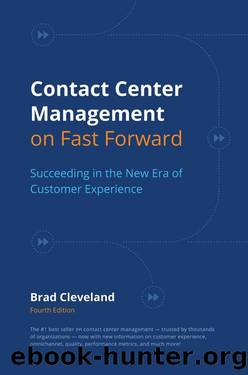Contact Center Management on Fast Forward: Succeeding in the New Era of Customer Experience by Brad Cleveland

Author:Brad Cleveland [Cleveland, Brad]
Language: eng
Format: epub
Publisher: ICMI
Published: 2019-10-13T22:00:00+00:00
The first and second delay announcements are valuable, but youâll need to use good judgment with repeating announcements, or they can make things worse. Keep in mind that customers often have you on speakerphone or are using a headset while they work on other things. (Once shunned by the general public, headsets are becoming de rigueur in the smartphone era.) Remember, they have to mentally tune in every time the announcement is played. Repeating announcements are repeating interruptions. âYeah, I know this call is important and that youâll be with me momentarily. Youâve told me eight times so far.â
That said, if subsequent announcements are interesting and valuable, they can be helpful in minimizing abandonment. I recall calling an airline to sort out some changes to a complex itinerary. They were backed up due to serious weather-related disruptions in their flight network, and various announcements covered such topics as: baggage policies, what can be carried on, vacation packages, the airlineâs mobile app, updates to the frequent flyer program, etc. The announcements were all different, and (even though I was familiar with the information) were interesting and well-timed. For this airline in this situation, it was a good approach. When considering a similar approach, let common sense and your companyâs personality and brand be your guide. (See the discussion on customer access strategy, Chapter 2.)
Extreme Alternatives
What if things are really rough? What if you get more contacts than expected and have exhausted all other alternatives? Should you continue to let customers into the queue? The choices, neither ideal, are to give callers busy signals (or limit âqueue depth,â as some put it) or let customers enter a long queue, only to abandon anyway.
Some centers could never consider using busy signals. Emergency services are a notable example. But for others, busy signals may occasionally be acceptable. Customers who get busy signals are more likely to make immediate and repeated attempts to reach you than those who abandon.
Busy signals are far less common in todayâs contact centers, but they remain enticing to some managers because they make reports look better and take the pressure off of agents. Some centers depend on them as a crutch for inadequate staffing. It probably goes without saying, but thatâs poor customer service, and it defeats the mission of the contact center. This tactic should only be used in extreme or short-lived situations.
Finally, there is the option to end all options: closing the center. During precipitous declines, times of national or world crises, and other such conditions, stock exchanges will suspend trading (the very thing theyâre there to enable). In the world of contact centers, Zappos (which has built a brand on delivering outstanding service) once temporarily stopped all calls and resorted to email in order to handle the workload deluge caused by a hacking incident that forced the company to change customer passwords.
Yes, this last-resort alternative is completely out of alignment with the contact centerâs mission to provide access. But a situation that forces you to consider such a drastic approach can happen, no matter how well youâve planned.
Download
This site does not store any files on its server. We only index and link to content provided by other sites. Please contact the content providers to delete copyright contents if any and email us, we'll remove relevant links or contents immediately.
Zero to IPO: Over $1 Trillion of Actionable Advice from the World's Most Successful Entrepreneurs by Frederic Kerrest(4068)
Machine Learning at Scale with H2O by Gregory Keys | David Whiting(3645)
Harry Potter and the Goblet Of Fire by J.K. Rowling(3612)
Never by Ken Follett(3535)
Ogilvy on Advertising by David Ogilvy(3345)
Shadow of Night by Deborah Harkness(3178)
The Man Who Died Twice by Richard Osman(2811)
Book of Life by Deborah Harkness(2723)
My Brilliant Friend by Elena Ferrante(2705)
How Proust Can Change Your Life by Alain De Botton(2617)
0041152001443424520 .pdf by Unknown(2603)
Will by Will Smith(2581)
The Tipping Point by Malcolm Gladwell(2563)
How to Pay Zero Taxes, 2018 by Jeff A. Schnepper(2503)
Purple Hibiscus by Chimamanda Ngozi Adichie(2494)
Hooked: A Dark, Contemporary Romance (Never After Series) by Emily McIntire(2424)
Rationality by Steven Pinker(2151)
Borders by unknow(2119)
Daughter of Smoke and Bone by Laini Taylor(2083)
